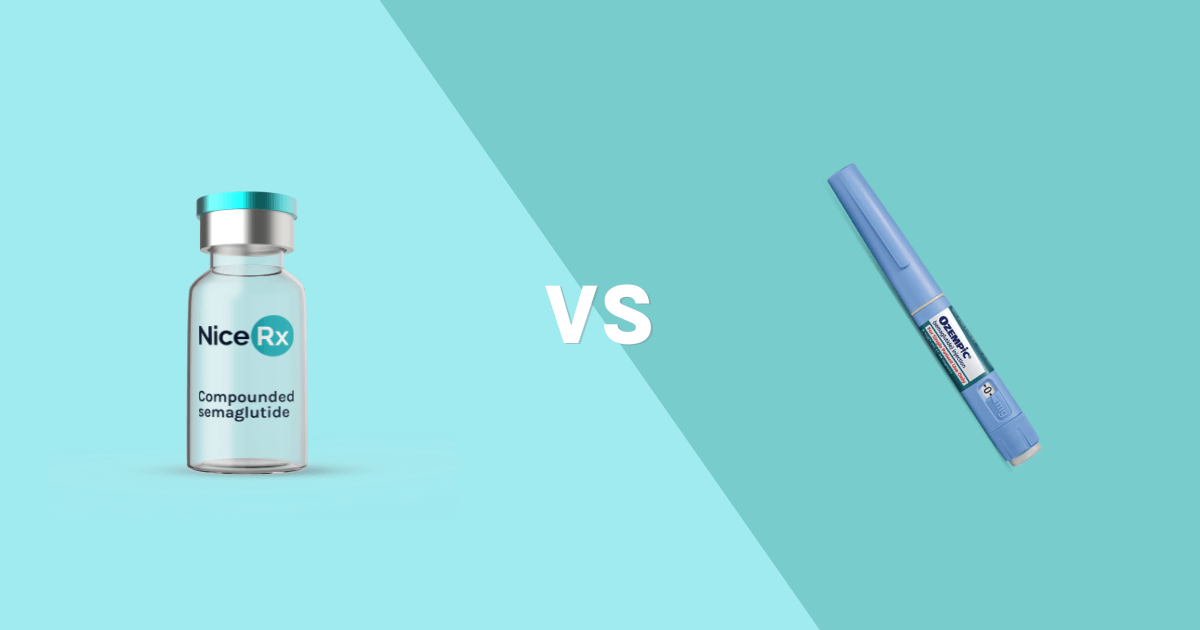Semaglutide vs. Ozempic: Which is better for weight loss?
Key highlights
- Ozempic is FDA-approved and tested for safety and effectiveness in managing blood sugar levels, while compounded semaglutide is not FDA-approved and may vary in quality.
- Compounded semaglutide can be a more affordable or customized option, especially during shortages, but its consistency and safety are not approved by the FDA.
- Consult with a healthcare provider to choose the best treatment for your needs, considering factors like cost, safety, and individual health goals.
Ozempic (semaglutide) is an FDA-approved glucagon-like peptide-1 (GLP-1) receptor agonists used for type 2 diabetes. It also helps with weight management in people with obesity and overweight.
Semaglutide and Ozempic are known to lower the risk of stroke, heart attack, or death for adults with type 2 diabetes and heart disease.
Compounded semaglutide is an individualized version of the GLP-1 (glucagon-like peptide-1) drug, made by compounding pharmacies and personalized for individual use.
The comparison between compounded semaglutide and Ozempic is important because Ozempic is a proven, FDA-approved medication, while compounded medications are not evaluated for safety and effectiveness by the FDA, although they are useful during times of shortages or when a patient needs a personalized medication without a specific ingredient, for example.
Continue reading to discover the key differences between compounded semaglutide and Ozempic, helping you make a well-informed decision about your treatment options.
What is Ozempic?
Ozempic (semaglutide) is an FDA-approved once-weekly glucagon-like peptide-1 (GLP-1) agonist used to control blood sugar levels in people with type 2 diabetes and reduce the risk of heart problems, like heart attacks. It lowers blood sugar by increasing insulin release and reducing sugar production in the liver. It’s .
Ozempic is also prescribed off-label for weight loss in people with obesity and overweight. It controls appetite and slows digestion, helping you feel full longer, which reduces food intake and supports weight loss. With off-label use, a medication is prescribed for a use other than that approved by the FDA.
Semaglutide is FDA-approved under three different brand names: Ozempic, Wegovy, and Rybelsus.
Wegovy is an FDA-approved weight loss medication manufactured by Novo Nordisk, used for chronic weight management in adults and children 12 years and older who are obese (with a body mass index of 30 or higher) or overweight (with a body mass index of 27 or higher) with at least one weight-related medical condition such as cardiovascular disease, high blood pressure, high cholesterol or type 2 diabetes.
Rybelsus was the first oral GLP-1 medication FDA-approved in 2019 for adults with type 2 diabetes.
What is compounded semaglutide?
Compounded semaglutide is prepared as needed for a patient or in small quantities at a compounding pharmacy.
When you get semaglutide from a licensed compounding pharmacy, it is made with semaglutide, the active ingredient in Wegovy and Ozempic, that can be adjusted by the pharmacy to suit your needs, if necessary. You will need a prescription from your healthcare provider.
Compounded semaglutide is a more affordable prescription medication than the brand-name version, but it is not FDA-approved, so its safety and effectiveness are not evaluated by the FDA.
The primary difference between compounded semaglutide and Ozempic is how they are made and regulated.
- Ozempic is a brand-name, FDA-approved prescription drug, which means it has been tested for safety and effectiveness.
- Compounded semaglutide is made by individual pharmacies and filled according to a healthcare professional’s prescription. It may not have the same strict quality controls as Ozempic, so it could vary in strength and reliability, depending on which compounding pharmacy you buy from.
Is semaglutide a generic for Ozempic?
No, there is no FDA-approved generic version of Ozempic. While you may see advertisements for generic Ozempic or generic semaglutide on less reliable websites, they may not be safe. Semaglutide is the active ingredient in Ozempic, and it could be used in a generic version once available in the future.
Currently, there are three FDA-approved forms of semaglutide:
- Ozempic is a subcutaneous injection for type 2 diabetes. It can also be prescribed off-label for weight loss.
- Wegovy is another once-weekly injection but has a higher dose of semaglutide (2.4 mg weekly). It’s FDA-approved for weight loss in people with obesity or overweight and have a weight-related health issue, like type 2 diabetes or high blood pressure.
- Rybelsus is an oral form of semaglutide. It is FDA-approved for controlling blood sugar in type 2 diabetes.
Is compounded semaglutide as effective as Ozempic?
Yes, both compounded semaglutide and Ozempic contain the same active ingredient, semaglutide, so they work similarly and have similar side effects. The main difference is that compounded semaglutide is custom-made to fit a person’s specific needs, such as different strengths or ingredients, which can help if someone has allergies to a particular ingredient in the brand name drug.
Compounded semaglutide can be a good option for people who can’t take the brand-name Ozempic for medical reasons. Some pharmacies also make it to help patients during shortages, so they can still get their medication.
Ozempic drug shortage
There is currently a shortage of FDA-approved semaglutide injections including Ozempic, which means it may be harder for some people to get the medication. This shortage has been caused by high demand and production delays.
If you can’t get Ozempic for medical reasons, you might consider compounded semaglutide. Speak with your doctor or pharmacist about whether compounded semaglutide is right for you.
Is compounded semaglutide safe?
Yes, compounded semaglutide can be safe, but it’s not FDA-approved, so it’s less regulated than brand-name medications like Ozempic. This means the quality and strength might vary.
The FDA has issued warnings for semaglutide, that some compounded semaglutide may contain salt forms of semaglutide, like semaglutide sodium or semaglutide acetate, instead of the base form found in FDA-approved drugs like Ozempic.
Semaglutide is typically the base drug, a medically appropriate form. When semaglutide is compounded as a salt, it can affect its safety and efficacy, and may lead to dosing errors or diminished efficacy.
There is no evidence to prove that these salt forms are safe or effective, and compounded semaglutide with these salts may not meet federal safety standards.
The high demand and cost of brand-name semaglutide products might lead people to use compounded versions. However, the company that makes Ozempic, Novo Nordisk, does not sell semaglutide for compounding, raising concerns about where compounded semaglutide comes from and the possible use of different formulas. Always use a reputable and state-licensed compounding pharmacy that adheres to the strict state and federal guidelines.
Is Ozempic or compounded semaglutide FDA-approved for weight loss?
No, Ozempic is not FDA-approved for weight loss, and compounded semaglutide is not FDA-approved for any use, although it may be available during shortages of other FDA-approved semaglutide medications.
Ozempic is FDA-approved to help people with type 2 diabetes manage blood sugar and lower certain risks, like heart attack, in people with heart disease.
There’s growing interest in using Ozempic for weight loss and many healthcare professionals are prescribing Ozempic off-label for weight loss.
If you’re looking for weight loss drugs, your healthcare provider might also prescribe Wegovy, which has the same active ingredient as Ozempic.
Wegovy is an FDA-approved medication for weight management, taken once a week. It helps reduce hunger and promotes weight loss. For best results, it should be used alongside lifestyle changes such as healthy diet and exercise.
Similarities between compounded semaglutide and Ozempic
- Active ingredient: Both compounded semaglutide and Ozempic have semaglutide as the active ingredient. The difference is how they are made and regulated; Ozempic is FDA-approved, compounded semaglutide is made by pharmacies and can vary in quality.
- GLP-1 receptor agonist mechanism: Both medications are GLP-1 receptor agonists. This means they mimic the action of a natural hormone called GLP-1 which helps regulate blood sugar by stimulating insulin release and reducing glucose production in the liver. They also slow down the emptying of the stomach, reduce hunger, and promote a feeling of fullness which can help with weight loss.
- Blood sugar and weight management: Both Ozempic and compounded semaglutide are used to control blood sugar in type 2 diabetes. Also, they help with weight management by reducing appetite, resulting in lower calorie intake.
What is better, compounded semaglutide or Ozempic?
Ozempic is FDA-approved, regulated, and proven to control blood sugar and weight loss. Compounded semaglutide is an option if there is a medication shortage or you need a customized dosage.
Some things to consider are:
- Medical history: Your healthcare provider will look at your overall health and any existing conditions like diabetes, heart disease, or allergies. This will help determine which is safer and more effective for you.
- Weight loss goals: If weight loss is your main goal, Ozempic may be prescribed off-label for that purpose. Wegovy, another semaglutide-based medication with a higher dose of 2.4 mg weekly available, is FDA-approved for weight management.
- Insurance coverage: Ozempic may be covered by insurance which can lower the cost. Compounded semaglutide is not FDA-approved so insurance may not cover it and it may be harder to get financial assistance for it.
- Eligibility for Ozempic savings card: Some people with private or commercial insurance coverage may be eligible for savings programs from the manufacturer, Novo Nordisk which can lower the cost of Ozempic. These savings cards are not available for compounded semaglutide.
- Budget: Ozempic can be very expensive without insurance and compounded semaglutide may be a more affordable option in some cases.
Your healthcare provider will play a big role in deciding what’s best for you. They will look at your medical history, goals, insurance coverage, and financial situation when recommending Ozempic, compounded semaglutide, or other options.
What is the difference between Ozempic and compounded semaglutide?
The key difference between compounded drugs and FDA-approved versions is that compounded drugs are not FDA-approved.
Compounded semaglutide is a custom-made version of the approved medication, often to fit a patient’s needs or during shortages, like the one affecting Ozempic. Compounded semaglutide is not FDA-approved for weight loss or any other use.
Compounded semaglutide is not standardized, meaning its quality and safety can vary, and it hasn’t been tested in clinical trials. While compounded semaglutide uses the same active ingredient (semaglutide) as Ozempic, some pharmacies might use semaglutide salts, which are not the same as the semaglutide used in Ozempic. Always check with the compounding pharmacy to ensure you are not receiving the sale form of semaglutide.
Ozempic is made by Novo Nordisk, the only company approved by the FDA to produce medications with semaglutide, including Ozempic, Wegovy, and Rybelsus. Compounded semaglutide is not identical to Ozempic, as it’s not made by the same company or regulated in the same way.
Dosage and administration
Ozempic comes in injectable pens, with each pen containing 4 to 8 doses. You need to attach a new needle for each injection. Compounded semaglutide usually comes in small glass vials, and you’ll use a syringe to draw your dose for each injection.
For both Ozempic and compounded semaglutide, the starting dose is 0.25 mg, injected once a week. After 4 weeks, the dose is increased to 0.5 mg per week. The recommended maximum dose is 2 mg per week.
Effectiveness
Clinical trials show that Ozempic is effective for both weight loss and controlling blood sugar in people with type 2 diabetes. Studies have shown that it can lead to significant weight loss and improved blood sugar control. There’s limited data on compounded semaglutide, as it’s not FDA-approved, so its effectiveness is not well-studied in clinical trials.
Ozempic has been shown to have long-term effectiveness in managing blood sugar and promoting weight loss when combined with diet and exercise. Compounded semaglutide’s long-term effectiveness is uncertain because it’s not regulated or studied and its results can vary from one batch to another.
With Ozempic, people usually start seeing weight loss and improved blood sugar control within a few weeks. It can take up to 3-6 months to see the full benefits. For compounded semaglutide, the time to see results may vary, depending on the formulation and individual response, but there’s no official data on its timeline.
Both compounded semaglutide and Ozempic can help people lose 15% to 20% of their body weight when taken consistently with diet and exercise over 12 to 18 months.
Side effects
Both Ozempic and compounded semaglutide can cause common side effects like nausea, vomiting, diarrhea, upset stomach, heartburn, constipation, and stomach pain.
While rare, semaglutide can cause serious side effects like hypoglycemia (low blood sugar), pancreatitis (inflammation of the pancreas), gallbladder problems (gallstones), and vision changes.
Semaglutide has a black box warning from the FDA for the risk of thyroid C-cell tumors.
Comparison of severity and frequency of side effects between semaglutide and Ozempic
- Since compounded semaglutide is not FDA-approved, the frequency and severity of side effects may vary depending on the formulation and individual response. Ozempic’s side effects are well-documented and tend to be mild, especially when the body adjusts to the medication.
- The most common side effect of Ozempic is nausea, which affects about 15% to 20% of people. Other side effects include vomiting (5% to 9%), diarrhea (8%), stomach pain (6% to 7%), and constipation (3% to 7%).
Long-term safety considerations
Ozempic has been studied for long-term safety, and it’s considered safe for most people when used as directed. Compounded semaglutide lacks extensive long-term safety data because it’s not FDA-approved. Therefore, its long-term safety is uncertain and may vary depending on the compounding process by the compounding pharmacy you purchase from.
Cost
Branded Ozempic is expensive, often costing around $1,000 or more for a month’s supply. Compounded semaglutide is more affordable, but the price can vary depending on the pharmacy and location.
Ozempic may be covered by insurance, but coverage can vary. Novo Nordisk offers savings programs to help reduce the cost for eligible patients, which can significantly lower the price for some people. There is no savings card program available for compounded semaglutide.
To make Ozempic more affordable, check if your insurance covers it and ask about savings programs. You can also compare prices at different pharmacies or look for discount cards online. For compounded semaglutide without insurance, shop around at different semaglutide compounding pharmacies to find the best price.
Bottom line
Ozempic is an effective, FDA-approved treatment for controlling blood sugar control and weight loss (off-label). Compounded semaglutide may work similarly as it contains the same active ingredient as the brand name drug, but without the testing and regulation of the FDA (U.S. Food and Drug Administration).
Ozempic is manufactured under strict regulations. Compounded semaglutide is made by compounding pharmacies and can vary in strength which can affect safety and efficacy, depending on the compounding pharmacy you from from.
Compounded semaglutide is a solution for those who can’t get FDA-approved semaglutide due to shortage or cost and can be customized to your needs with the guidance of a healthcare provider.
Both drugs can help people lose between 15% to 20% of your body weight when combined with a healthy diet and exercise. Before choosing between Ozempic and compounded semaglutide, discuss your health goals, insurance coverage, and any potential side effects with your healthcare provider to find the most effective and safe treatment.









